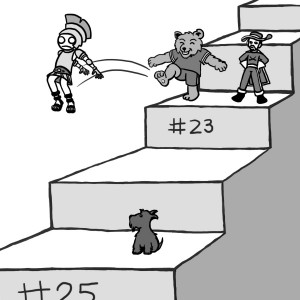“America’s Best College” does not exist
College app season — that time of year is here once again. Nationwide, high school students and parents alike are now getting ready for the quest to find a perfect fit for the next four years. More often than not, the search begins with rankings. Early last month, U.S. News & World Report released the latest edition of its “Best Colleges” list, widely accepted as the go-to for college rankings.
USC placed 25th on the U.S. News rankings this year, but placed fourth on the list of schools with the most billionaire undergraduate alumni, recently released by Wealth-X and UBS Billionaire Census. In fact, the obsession with rankings has spurred new lists based on all kinds of criteria; everything from best dorm food to most beautiful campus to highest starting salaries of recent graduates. In light of the increasing number of rankings, it’s hard to tell which lists have real merit.
Biased and trivial, the criteria for the U.S. News rankings have little to do with actual student satisfaction and more to do with schools’ reputations and historic prestige. “Undergraduate academic reputation” accounts for a whopping 22.5 percent of the weighing in the ranking formula. This reputation doesn’t come from undergraduate student input, but rather from an assessment by top administrators — deans, presidents and provosts — of peer institutions. This creates a cycle in the rankings process: Top academics evaluate a peer institution based on its reputation, which was established in the prior year’s rankings, which in turn prevents schools from moving dramatically up or down in the rankings during any given year.
Finances also play a large part in the U.S. News ranking methodology. Faculty resources, financial resources and alumni giving rate add up to 35 percent of the total weight. Financial resources are judged by per-student spending, but U.S. News doesn’t account for the fact that high per-student spending is often funded through high per-student tuition.
Not coincidentally, some of America’s “top colleges” are also those known for their costly tuition. The high demand for top schools means that they can get away with exorbitant prices.
Blatantly absent from U.S. News’ criteria are factors like affordability and student satisfaction. Including these factors would force colleges into a competition to improve themselves for their students. If affordability were a factor, colleges would set costs that would better help students out, and the rankings system would inspire competition that benefits students. Instead, schools are rewarded for their financial and faculty resources.
Perhaps the most pointless criterion for the ranking is the “selectivity” factor. Just as how “undergraduate academic reputation” creates a cycle of rewarding the same schools, the selectivity factor makes it harder for new schools to break into the top list. When a school is named one of America’s top colleges, more students will apply there, increasing the selectivity. This lowered rate of admissions will then help the school in the next year’s rankings, and since the school remains on the top list, its selectivity rate will remain high.
Obviously, these rankings should mean more to the schools themselves than to students looking for prospective colleges. The U.S. News and World Report ranking system is essentially just a way for elite colleges to pat themselves on the back and justify rising tuition costs.
Simply comparing the U.S. News rankings to rankings that utilize different criteria exemplifies this. For example, the Washington Post recently released a list of the colleges that graduates had the highest average starting salaries, which seems more helpful to students than endowment or selectivity. Not a single one of the top 10 schools on the Washington Post’s list were Ivy League universities, which made up half of U.S. News’ top 10.
Unfortunately, many high school students rely heavily on well-known rankings like U.S. News during their college search process. Most students don’t apply exclusively to top 10 schools, but many students rely on the rankings when choosing their “dream schools.” Just because a school received the number one ranking, however, doesn’t mean it should be everyone’s number one choice. Top schools won’t necessarily be the best choice for every student. For instance, Caltech (ranked 10th) might not be the best option for an English major.
When choosing a school, students should ignore the rankings and focus on factors like environment, academic programs for their specific major and affordability. Instead of allowing U.S. News & World Report to tell them which school is the best, students need to do their own research and attend a school that will meet their personal needs and interests — regardless of that school’s rank.



Erin,
People know Caltech isn’t a school for softology majors. That’s where they learn about things such as sending biga55 space shuttles 100’s of thousands if not millions of miles into space. You know that black and white space craft across the street, with NASA on it, that was literally piggybacking off of a commercial jetliner sometime last year? That’s what Caltech deals with. English don’t teach you that; but I’m sure all universities offer courses on English.
Don’t get so bent out of shape with these biased, unscientific, and non quantitatively concluded rankings. It’s a game. And who cares if that school across town beat us, or the fact that London Times FAVORS them over us? They’re a CA school, and because of their “in state” tuition they will always be favored over us and be “the most applied to” school. But that may change in the next few years as the UCs are trying to attract more out-of-state and international students…Oh wait, we already do that WELL.
Last thing, Harvard and Stanford got the highest concentration of influential, game-changing, disrupter, billionaire alumni. So maybe SC falls in 3rd place after these two like you stated.